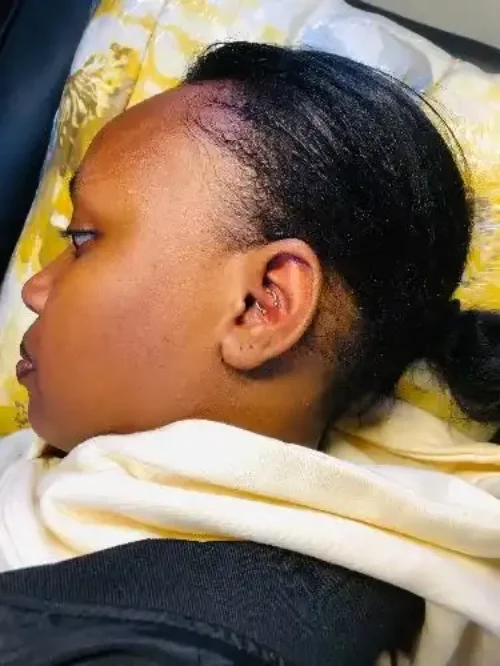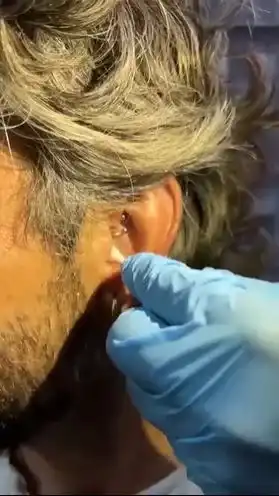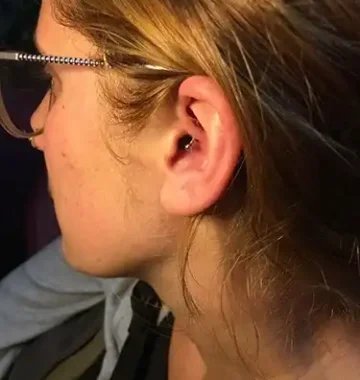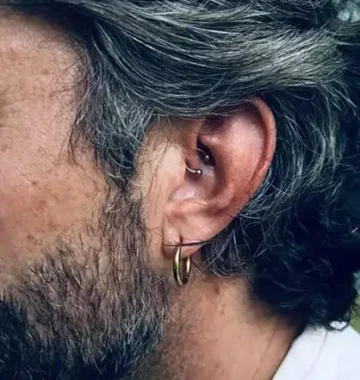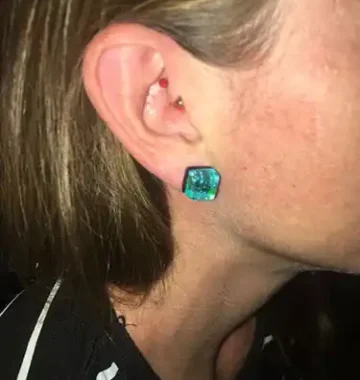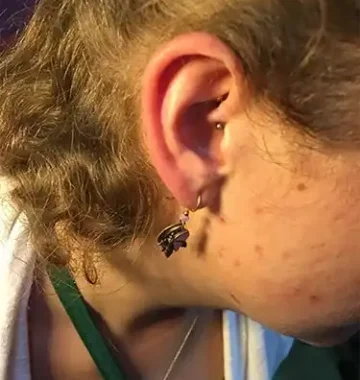Daith Piercing in Nairobi, Kenya
A daith piercing is a type of ear cartilage piercing that goes through the innermost fold of the ear, located above the ear canal. It’s known for its distinctive placement, which makes it both a unique fashion statement and, according to some, potentially beneficial for certain health conditions.
Daith Piercings
- Aesthetic Appeal: The daith piercing is loved for its edgy yet elegant appearance, especially when adorned with small rings or captive bead hoops. Many people choose subtle, decorative jewelry that complements the unique shape of the piercing.
- Pain Level and Healing Time: The pain level varies by individual, but since the daith area is thicker cartilage, it can be more uncomfortable compared to earlobe piercings. Healing typically takes 6-9 months, though it can vary. Proper aftercare is crucial to prevent infections and ensure a smooth healing process.
- Health Claims: Some of our clients have reported that daith piercings help reduce migraine symptoms, as they may target an acupuncture point associated with headache relief. However, there’s limited scientific evidence supporting this, so results vary.
Daith Piercing Procedure
The daith piercing procedure is unique due to its challenging placement in the ear’s innermost cartilage fold. It’s important to choose an experienced piercer, as precision is essential for a smooth procedure and a successful healing process. Here’s a step-by-step breakdown of what to expect during a daith piercing:
- Preparation
– Consultation: Our piercer will examine the shape of your ear to ensure it can accommodate a daith piercing, as not all ear anatomies are suitable.
– Sterilization: They will clean and sterilize the area to reduce the risk of infection. This is usually done with a medical-grade disinfectant.
– Marking: Our piercer will mark the exact spot for the piercing, typically using a sterilized pen to ensure correct placement. - Piercing
– Clamping: Some of our piercers use a small clamp to hold the cartilage steady, but others may use a freehand technique for more control in such a small area.
– Needle Insertion: Using a sterile, hollow needle, our piercer will puncture the cartilage. This can cause a quick, sharp sensation, as cartilage is thicker and requires more pressure to pierce than softer tissue.
– Jewelry Insertion: After the hole is made, our piercer will insert the chosen jewelry, usually a small captive bead ring or a curved barbell that sits comfortably within the fold of the ear. - Aftercare Instructions
– Cleaning: You’ll be advised to clean the piercing twice daily with a saline solution to prevent infection and reduce swelling.
– Avoid Touching: It’s important not to twist or fiddle with the jewelry during healing to minimize irritation.
– Sleeping Position: Avoid sleeping on the pierced side to reduce pressure, and keep hair and other potential irritants away from the piercing site. - What to Expect After the Piercing
– Healing Time: A daith piercing typically takes between 6 and 9 months to fully heal, although this can vary based on aftercare practices and individual healing rates.
– Potential Discomfort: Mild swelling, soreness, and sometimes bruising are normal in the initial days after the procedure.
Tips for Choosing Jewelry
Choose high-quality materials such as surgical steel, titanium, or gold to minimize the risk of irritation and allergic reactions.
Considerations before getting a Daith Piercing
Before getting a daith piercing, it’s essential to be aware of several factors to make an informed decision. While a daith piercing can be a beautiful and unique addition, it requires careful consideration due to its specific placement and healing requirements. Here’s a list of important things to think about:
- Anatomy Suitability: Not all ears are suited for a daith piercing due to the structure of the inner ear cartilage. It’s best to consult with a professional piercer who can assess whether the piercing is possible with your anatomy.
- Pain Level: The daith is located in a thick part of the cartilage, so the piercing can be more uncomfortable compared to others, especially if it’s your first cartilage piercing. Pain tolerance varies, but be prepared for a quick, sharp sensation during the procedure.
- Healing Time and Commitment: Daith piercings typically take between 6 and 9 months to heal, and sometimes even longer depending on aftercare and individual healing rates. This requires consistent aftercare to avoid complications, such as infections or irritation.
- Aftercare Requirements: Cleaning with saline solution twice a day is essential. Avoid twisting, touching, or sleeping on the piercing, as these actions can cause irritation and slow the healing process. Aftercare commitment is crucial for successful healing, so be prepared for the daily routine.
- Jewelry Choice: Opt for high-quality jewelry made from materials like titanium, surgical steel, or gold to reduce the risk of infection and irritation. Since the daith is a more delicate area, proper jewelry can make a significant difference in comfort and healing.
- Migraine Relief Claims: Some people get daith piercings hoping it will relieve migraines, as it supposedly targets an acupuncture point associated with headache relief. However, evidence on this is anecdotal, and there isn’t strong scientific backing for this claim. Results vary widely, so it’s best to view the piercing primarily as an aesthetic choice.
- Finding an Experienced Piercer: Due to the challenging location of the daith, it’s crucial to choose a highly skilled, experienced piercer. Look for a studio with excellent hygiene practices and positive reviews, as a poorly performed piercing can lead to serious complications.
- Cost Considerations: The price of a daith piercing can vary based on the studio and jewelry choice. High-quality jewelry and a reputable piercer may cost more but can reduce the risk of complications, ultimately saving you from additional expenses in the long run.
- Potential Risks and Complications: As with any piercing, there’s a risk of infection, swelling, and scarring. Following aftercare instructions and choosing an experienced piercer can minimize these risks, but it’s important to be aware of the potential for complications.
- Work or Lifestyle Impact: Some workplaces or activities might be impacted by a new piercing, especially during the healing period. If your lifestyle includes regular use of headphones, helmets, or anything that might press on the ear, this piercing could be challenging to manage.
Pain and Healing for a Daith Piercing
The pain and healing process for a daith piercing are unique due to its placement in the thick cartilage fold above the ear canal. Here’s a breakdown of what to expect in terms of discomfort and healing:
Pain Level
- During the Procedure: Pain can vary, but most people report a sharp, quick sensation during the piercing, as the needle goes through dense cartilage. Because of the thickness of the daith area, the procedure might feel slightly more intense than softer-tissue piercings, like earlobes.
- Immediately After: There may be an aching or throbbing sensation right after the piercing, which typically subsides within a few hours to a couple of days. Some people also experience mild swelling and tenderness around the area.
Healing Process
- Initial Healing (First Few Weeks): The piercing site will likely be sore, and some swelling or redness is normal. It’s crucial to keep the area clean during this time to prevent irritation and infection.
- Ongoing Healing: Daith piercings generally take anywhere from 6 to 9 months to fully heal, although individual healing rates vary. For some, healing may even extend up to a year. Proper aftercare can support healing and reduce the risk of complications.
- Full Healing: After around 6 months, the piercing should be more stable, though it’s recommended to continue gentle care until it feels entirely healed.
Tips for Managing Pain and Supporting Healing
- Aftercare: Clean the piercing with a saline solution twice daily, avoiding alcohol-based solutions as they can dry out and irritate the area.
Avoid Touching: Resist the urge to twist or touch the jewelry, as this can introduce bacteria and delay healing. - Sleeping Position: Avoid sleeping on the side of the new piercing to minimize pressure and friction.
- Choose Quality Jewelry: High-quality materials (like titanium or surgical steel) reduce the likelihood of irritation and allergic reactions, promoting a smoother healing process.
Potential Complications to Watch For
- Infection: Signs include excessive swelling, redness, and discharge. If you notice any of these, consult with your piercer or a healthcare provider.
- Keloids or Bumps: Some people are prone to keloids or hypertrophic scarring with cartilage piercings. Good aftercare reduces this risk, but if a bump forms, your piercer may recommend specific treatments.
Daith Piercing Aftercare
Aftercare for a daith piercing is essential for proper healing, as the cartilage location requires special attention. Here’s a detailed guide you can share with clients to help them care for their new piercing:
- Daily Cleaning Routine
– Saline Solution Soaks: Clean your piercing twice a day with a sterile saline solution. You can do this by soaking a cotton ball or using a saline spray and gently applying it to the area. Avoid using alcohol, hydrogen peroxide, or any harsh chemicals, as these can irritate the piercing.
– Rinse After Cleaning: Gently rinse the area with clean water after applying saline solution, then pat it dry with a clean, disposable paper towel. Avoid cloth towels, as they can harbor bacteria. - Hands Off!
– Avoid Touching: Resist the urge to touch, twist, or rotate the jewelry, as this can introduce bacteria and disrupt healing.
– Keep Hair and Products Away: Make sure to keep hair, hair products, and any skincare products away from the piercing site to avoid irritation. - Be Gentle with Sleeping and Headphones
– Sleep Position: Try not to sleep on the side of the piercing. Use a travel pillow or sleep on the opposite side to prevent pressure on the piercing.
– Avoid Headphones and Earbuds: Avoid wearing headphones or earbuds on the pierced ear for at least the first few weeks to prevent irritation. Opt for over-the-ear headphones on the opposite ear, if necessary. - Watch for Signs of Infection: Normal vs. Concerning Symptoms: Mild redness, tenderness, and slight discharge are normal in the initial days. However, if you notice increased swelling, heat, thick discharge, or extreme pain, these may be signs of infection. In such cases, consult with your piercer or a healthcare provider.
- Long-Term Aftercare
– Continue Cleaning for the Full Healing Period: Daith piercings typically take 6 to 9 months to heal fully. Even if the area feels healed after a few weeks, continue cleaning to prevent complications.
– Avoid Changing Jewelry Early: Wait until the piercing is fully healed before changing the jewelry. Swapping it out too soon can irritate the site and prolong healing. - Jewelry Quality Matters: Choose Hypoallergenic Jewelry: Using high-quality jewelry (such as titanium or surgical steel) from the beginning can minimize irritation and help the healing process. Avoid cheaper metals that can cause allergic reactions.
Schedule Appointment
Daith Piercing Jewelry
Choosing the right jewelry for a daith piercing is key to comfort, style, and smooth healing. The unique placement of the daith piercing—inside the innermost cartilage fold of the ear—means that certain jewelry types work better than others. Here’s what to consider when selecting jewelry for a daith piercing:
Best Jewelry Types for Daith Piercings
- Captive Bead Rings: These are classic for daith piercings and consist of a hoop with a small bead that snaps into place. The seamless circular design is comfortable and stylish, and the bead can add a touch of personality.
- Clicker Rings: Clickers are popular for their ease of use. They feature a hinged segment that “clicks” into place, making them easier to insert and remove. Clickers come in a range of styles, from simple and sleek to ornate and jeweled.
- Curved Barbells: If you prefer a unique look, a small curved barbell can work for a daith piercing, though it’s less common. This option may be more comfortable for some people during the initial healing period.
Jewelry Materials for Daith Piercing
- Titanium: Lightweight, hypoallergenic, and safe for healing, titanium is an excellent choice for first-time piercings, especially for those with sensitive skin.
- Surgical Steel: Also hypoallergenic and durable, surgical steel is often used for initial piercings. Be sure it’s high-quality to avoid nickel, which can cause irritation in some people.
- Gold (14K or 18K): If you prefer gold, opt for 14K or 18K solid gold (not gold-plated), as it’s hypoallergenic and safe for healing. Avoid higher karats, as softer gold can scratch easily.
- Niobium: A lightweight, hypoallergenic metal similar to titanium, niobium is another safe option for daith piercings.
Styles and Designs
- Minimalist and Simple: Simple hoops and clickers are elegant and timeless, perfect if you prefer a subtle look.
- Jeweled and Decorative: For a bold statement, you can find clickers with crystals, opals, or intricate designs. These are best saved for after the piercing has healed to avoid snagging or irritation.
- Unique Shapes: Some people choose heart or moon-shaped hoops for their daith piercing. These can add personality and style but may require a longer healing period due to the shape.
Changing Jewelry: When and How
- Wait Until Fully Healed: Changing jewelry too early can interrupt healing and introduce bacteria. Wait at least 6-9 months, or consult with your piercer to confirm if it’s safe to switch.
- Get Help from a Professional: Daith piercings can be tricky to change due to their placement. Many people prefer to have their piercer change the jewelry to ensure it’s done safely. Contact Us to get in touch with one of our piercers who can assist you in changing out your jewelry.
Daith Piercing Jewelry Care
- Regular Cleaning: Even after the piercing has healed, keep the jewelry clean by rinsing with saline or gently wiping it with a soft cloth.
- Avoid Cheap Metals: Nickel-based or low-quality metals can irritate the skin and cause reactions. Stick to hypoallergenic options to ensure comfort and longevity.
Cost of a Daith Piercing in Nairobi, Kenya
The cost of a daith piercing can vary based on several factors, including the studio location, the experience of the piercer, and the quality of the jewelry. Here’s an overview to give your clients a sense of what to expect:
Average Price Range
- In most places, a daith piercing typically costs between Ksh. 1,500 and Ksh. 2,500. Higher-end studios or those in major cities may charge more due to expertise and demand.
- Jewelry Quality: Many studios include basic jewelry in the initial price, but upgrading to high-quality materials like titanium, gold, or decorative options may add Ksh. 300 to Ksh. 1,500 or more to the total.
Factors Influencing the Price
- Piercer’s Experience: Highly experienced or specialized piercers often charge a premium, especially for intricate placements like daith piercings. At Rebel Inks Tattoos, Tattoo Removal, and Body Piercings Parlour we have experienced professionals who offer quality and premium services.
- Studio Location: Prices tend to be higher in major cities or trendy areas, while smaller towns or less central locations might have lower rates. Rebel Inks Tattoos, Tattoo Removal, and Body Piercings Parlour is located in the heart of the Central Business Disrict (CBD) in Nairobi, Kenya, and is easily accessible to both locals and foreigners in the country.
- Jewelry Choice: Upgrading to hypoallergenic or more elaborate jewelry (such as a titanium clicker with gemstones) increases the cost. Premium materials are recommended for sensitive skin and better healing.
What’s Included in the Cost
- Consultation: The initial consultation, sterilization, and setup are usually included.
- Basic Jewelry: Most studios include simple jewelry with the piercing, like a basic hoop or ring.
- Aftercare Instructions: At Rebel Inks Tattoos, Tattoo Removal, and Body Piercings Parlour we provide aftercare instructions and sometimes even a saline solution or aftercare kit as part of the price.
Additional Expenses
- Jewelry Upgrades: Fancy clickers or hypoallergenic materials (like solid gold) can add Ksh. 500 to Ksh. 2,000.
- Aftercare Products: At Rebel Inks Tattoos, Tattoo Removal, and Body Piercings Parlour we sell saline solutions or piercing aftercare products, which may cost an additional Ksh. 300 to Ksh. 1,000 if not included.
- Follow-Up Visits: Some of our piercers offer complimentary check-ups, while others may charge a small fee for follow-up care or jewelry adjustments, Contact Us for further inquiries.
Daith Piercing Cost Breakdown Table
Component / Service | Estimated Cost (KSh) | Details / Notes |
Piercing procedure + basic jewelry | 1,500-2,500 | Base rate |
Jewelry upgrade (e.g., gold or ornate clickers) | 500 – 2,000 | Premium materials or style |
Aftercare kit (saline spray/cleanser) | 300 – 1,000 | For post-piercing care |
Follow-up/checkup visits | Possibly complimentary or small fee | |
Estimated Total (Basic Package) | 2,000 – 3,000 | Procedure plus base jewelry and minimal add-ons |
Estimated Total (With Upgrades) | 3,300 – 5,000 | Includes premium jewelry and aftercare kit |
Possible side effects of Daith Piercing
Like all piercings, a daith piercing can come with potential side effects. Knowing these risks can help your clients make informed decisions and understand when to seek help. Here’s a breakdown of possible side effects and how to manage them:
- Initial Pain and Swelling
– What to Expect: Mild pain, tenderness, and swelling are normal for the first few days after a daith piercing. The pain should gradually decrease within a week or two.
– How to Manage: Use cool compresses and take over-the-counter pain relievers if needed. Be sure to follow aftercare instructions to minimize discomfort. - Infection
– Signs of Infection: Look out for increasing redness, warmth, pus-like discharge, or persistent pain that worsens over time. Infections can develop if bacteria enter the piercing site, often from touching it with unwashed hands.
– How to Prevent & Manage: Avoid touching or twisting the jewelry, and clean the area with saline solution twice daily. If an infection develops, consult a professional piercer or healthcare provider. - Cartilage Bumps (Hypertrophic Scarring)
– What Are They: Raised bumps (often called “piercing bumps”) can form near the piercing site due to irritation, trauma, or infection.
– How to Manage: Clean the piercing consistently, avoid unnecessary movement of the jewelry, and try not to sleep on it. Saline soaks may help, and if the bump persists, consult a piercer for additional advice. - Keloids
– What Are They: Keloids are thick, raised scars that can develop around piercings, particularly for those prone to scarring.
– How to Manage: If you’re prone to keloids, consider discussing this with your piercer beforehand. Avoid irritating the piercing, and if a keloid forms, consult with a dermatologist or piercer for potential treatment options. - Allergic Reactions
– Signs of Allergy: Redness, itching, and inflammation can be signs of an allergic reaction, usually to certain metals like nickel.
– How to Prevent: Choose hypoallergenic jewelry materials, like titanium or surgical steel, which are less likely to cause a reaction. If you suspect an allergy, switching to hypoallergenic jewelry can help. - Migration or Rejection
– What Is It: Although rare with daith piercings, jewelry can sometimes migrate or the body may reject it if it’s under too much pressure or poorly positioned.
– How to Manage: Choosing a professional, experienced piercer reduces the risk of migration or rejection. If you notice the piercing shifting position, consult your piercer as soon as possible. - Delayed Healing or Piercing “Blowout”
– What Is It: Due to the thickness of cartilage, daith piercings can take 6-9 months or more to heal. If irritated, a blowout (a ring of scar tissue) can form around the back of the piercing.
– How to Manage: Avoid sleeping on the pierced ear, and follow aftercare instructions closely. Gentle, consistent aftercare is essential, even if the piercing feels healed after a few weeks.
Get In Touch
For more information on the list above and any other special services,please call or come in for free consultation
Testimonials
After he pierced my industrial piercing and seeing his amazing work, I feel even more excited about getting my tattoo with him in January. I’m really looking forward to it!
I am extremely happy with my new 'Safari' tattoo from Eric at Rebel Inks! The quality of the artwork is fantastic. Eric is a true professional and an amazing artist.
The preparation and design process was thorough and collaborative. He was very patient with my specific requests, including making sure all the elements, which hold personal meaning, were perfect.
The service was friendly and highly professional from start to finish. Despite the 8-hour session, Eric was a pleasant person to spend the time with.
The aftercare guidance and follow-up have been excellent and careful, which has made the healing process easy and better than expected.
I highly recommend Eric for anyone looking for a thoughtful, talented, and caring tattoo artist.
I recommend them 💯
I would definitely recommend if you’re thinking of getting a piercing!
The staff were super friendly, explained everything clearly, and made me feel so at ease. They answered all my nervous questions (and I had many questions),
They walked me through the whole process, gave detailed aftercare instructions, and even followed up afterward to check how I was healing 🫶
Clean, professional, and full of good vibes.
Would 100% recommend . Definitely making a second trip here.
This was the second tattoo I got and I wish I could have come to Eric for my first one! He gave me really great after-care directions for the tattoo as well as a little jar of his own Vaseline-type stuff to put over my tattoo while it was healing! He even put second skin over my tattoo so that I didn’t have to worry about it for the first few days. Now THAT’S good service. My first tattoo artist didn’t do none of that lol.
After the session Eric didn’t rush me and my friend out, he chatted with us and even when he found out I was an artist too— really encouraged me to keep creating and to find a community of artists to support me. I almost cried because I’ve had such a hard time with my own art the past couple of years, it meant so much to me to have a fellow very talented artist say that to me. 🤍🤍🤍
Eric you’re amazing, don’t ever stop creating and just know you’ve impacted lives all over the world!🫶🏻 thanks so much for everything!!
From the moment I walked in, Eric was professional, welcoming, and attentive. He made sure I was comfortable throughout, provided everything I needed, and explained every step of the process. The tattooing itself was unbelievably smooth - I genuinely felt no pain compared to my previous tattoos over the last 22 years.
Eric also gave me excellent aftercare guidance and products, and thanks to that, my tattoo healed beautifully. The attention to detail, precision, and shading are absolutely stunning. This is hands-down the best tattoo I've ever had, and I will be flying back to Nairobi for any future ink.
If you want incredible art, a professional experience, and a talented artist who truly cares about his clients, Rebel Ink is the place to go!
From start to finish, the service was exceptional. The piercer was professional, knowledgeable, and made me feel completely comfortable. The cleanliness of the place was above and beyond — everything was spotless and hygienic, which really put me at ease. Highly recommend for anyone considering a piercing!
Shout out to Eric😘
We ended up changing the jewelry three times to ensure I had the best fit and avoided any signs of rejection, and he always listened to my suggestions as a client, which I really appreciated. Now, three months in, my piercing is healing beautifully, with no sign of rejection. Highly recommend for anyone who values a piercer who cares about your comfort and healing journey!
What stood out the most was the aftercare Eric checked in with me even three weeks later to see how the tattoo was healing. That kind of follow-up shows how much he truly cares about his work and his clients.
I’m very satisfied and will definitely be coming back for my next piece. Highly recommend!
The piercing wasn't as painful as I had thought and the process was quick and satisfactory. I love it!!!
The piercing is healing well thanks to the aftercare instructions and follow-up. I would highly recommend Rebel Inks
Eric also did a belly button piercing for a friend, guiding her through the process, doing the piercing and then explaining the after care to her.
The shop is on the 3rd floor, with the entrance to the stairs near an alleyway on the left. The shop is perfect size, clean, and attractive looking. The mural is pretty dope.
Thank you for the amazing service! 🔥👅✨
I got piercibgs there and the process was really good. My biggest concern was hygiene but that wasn't an issue at all, they use new needles and they sanitize them.
The service itself was also welcoming.
I was informes of everything i needed to know beforehand.
10/10 would recommend!
Eric was so calm and patient with my almost 2 year old lady. It was such a clean and hygienic process. We will definitely be back for our second rounds of piercings and maybe even another tattoo!
They assess the area before any art and advise one accordingly. They also give one post clean up process and also do a check up after the body art projects. Overall, I loved my experience and I’m hooked. 👍
Will definitely come back next time I’m in town 🙂
He listened to what I actually wanted and made sure he could fit in the time before I flew back home.
The shop is clean & private and is easy enough to find.
Eric has even checked in a couple of times since to make sure all is good.
I would totally recommend Eric! I absolutely love my Elephants!
I had a very easy healing period and always follow up from Eric to check on my progress...I would highly recommend if you are a first timer because from my experience all went very well and attention to detail
Thank you for a good job and looking forward to send all my friends your way
And all the best with the new year 2025!
From the moment I walked in, the staff was super friendly and made me feel at ease. The studio had a clean, professional atmosphere, which immediately put me at ease. My piercer was incredibly skilled and explained every step of the process, ensuring I was comfortable the entire time. The piercing was quick and practically painless, and the aftercare instructions were clear and easy to follow. I can tell they really care about the health and safety of their clients.
Overall, a fantastic experience—I highly recommend Rebel Inks and Tattoos for anyone looking to get pierced or tattooed!
They do follow up after their services
Eric's Studio isn’t just a place to get a tattoo—it’s an experience. The combination of professionalism, artistic talent, and a welcoming environment makes it a standout destination for anyone considering a tattoo.
I highly recommend Eric’s Studio to both first-timers and seasoned tattoo enthusiasts. If you’re looking for a high-quality tattoo and an enjoyable experience, this is the place to go.
I would definitely recommend their services again and again
Thank you Rebel Ink
My piercings are healing ❤️🩹 well
I would 💯 recommend
I will definitely come back for more .
Two, all the equipments he used for the piercings were new and/or sterilised.
Three, the parlour itself was very clean and was up to par with the hygiene standards.
Four, Eric provided effective aftercare instructions, making sure I knew exactly how to take care of my new piercings and he kept in touch and continues to do so, to check on the healing progress.
I highly highly highly recommend this place!!!
Would definitely recommend them to friends and go back for other piercings
Not only was the piercing process smooth, but he also provided thorough aftercare instructions, making sure I knew exactly how to take care of my new piercings. What really impressed me was that he keeps in touch to check on how the healing is progressing – a sign of true care for his clients.
The shop maintains a high standard of hygiene, and the atmosphere is welcoming and comfortable, which really added to the positive experience. I highly recommend this place to anyone looking for a professional and caring experience. I’ll definitely be coming back for any future piercings!
My appreciation for the excellent customer service I received. The follow-ups were prompt, and I truly appreciated the gentleness and professionalism throughout. Thank you!"
"Looking for professional eyebrow microshading removal? Look no further!"
The customer care is top tier 👌🏾👌🏾.
Wonderful place to get tattoos and piercings. 💯💯
Eric goes ahead to follow up on his clients progress and gives good advice each time I reach out to him.
I would recommend Reble tattoos anytime.
Good job bro we really appreciate.
Ohh and the price is very fair.
The environment was clean , procedure was sterile and the jewelry used are of the best quality.
He followed up with me during the healing process, he educated me on what I needed to do for my aftercare.
Eric is confident, skilled , experienced and the best piercer. Highly recommend Rebel inks.✨
Definitely recommend!
Great experience.
Eric definitely know what he is doing .
I got exactly what I wanted 2 tiny tats on the same finger .
He was kind and patient throughout the session.
Healing process has been good .
Aftercare services were given and regular checkups on the healing process were done.
I would 💯recommend.
Eric gave me the best reception as it was my first time there,and made me trust him all the way. I appreciate good services.
There services are also affordable not to forget 😊.
He was also invested in the aftercare and would ensure I follow the do's and don'ts in taking care of the tattoo and ensuring proper healing and maximum ink retention.
Would highly recommend Rebel Inks Tattoos.
Rebel Inks Tattoo offer the best,affordable and quality tattoo removal services.If you have unwanted ink,choose Rebel Inks Tattoo,they're the best of the best and the professionalism is a top notch.They ensure you're free from unwanted ink with their Laser Tattoo Removal Technology...
I did a Laser Tattoo Removal with them and i can attest they're the best....
Kudos Eric...
I highly recommend.
It was a generally good experience with good hygiene during the piercing process and has been a smooth healing process.... 10/10
tips. Highly recommend 👍🏽
100% recommendable.
I was particularly impressed with Eric's attention to hygiene. He thoroughly cleaned the room before I entered, sanitized all of the equipment he would be using, and changed gloves between each ear. This level of cleanliness gave me great confidence in his professionalism.
Eric's commitment to customer service did not end on the day of the piercing. He followed up with me regularly throughout the healing process to ensure that I was following the aftercare instructions and that my earlobes were healing properly.
I highly recommend Rebel Inks to anyone in Nairobi who is considering getting a piercing. Eric is a highly skilled and experienced piercer who takes great pride in his work.
So I Check all the boxes below and more:
Customer Care: ✔️
Professionalism : ✔️
Cleanliness ✔️
Price: ✔️
After care service ✔️
Thanks and good job, Eric
The place is neat and clean and the equipments he used were also fine standards. Really appreciate his following up with me on the healing 🤗
I WOULD HIGHLY RECOMMEND THEIR SERVICES to everyone. Actually what you see on their website is EXACTLY what you will get. Keep up the good work Rebel inks Tattoos.
The infection is now gone. I would definitely recommend!
Can recommend this place totally and would go back there anytime!
Thanks!
OUR LOCATION
Areas We Serve
NAIROBI
KIAMBU
KAJIADO
MACHAKOS

